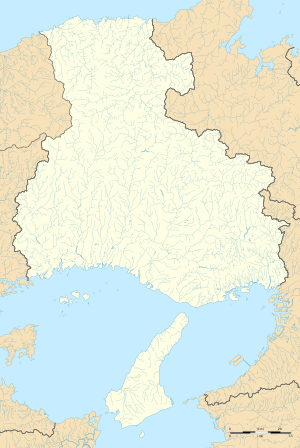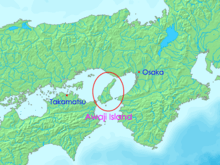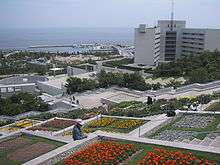Awaji Island
Awaji Island (淡路島, Awaji-shima) is an island in Hyōgo Prefecture, Japan, in the eastern part of the Seto Inland Sea between the islands of Honshū and Shikoku. The island has an area of 592.17 square kilometres (228.64 square miles),[1]. It is the largest island of the Seto Inland Sea.
| Native name: 淡路島 Awaji-shima | |
|---|---|
 Satellite view of Awaji Island | |
 Awaji Location in Japan  Awaji Awaji (Hyogo Prefecture) | |
| Geography | |
| Location | Seto Inland Sea |
| Coordinates | 34°23′N 134°50′E |
| Area | 592.17 km2 (228.64 sq mi) |
| Length | 53 km (32.9 mi) |
| Width | 28 km (17.4 mi) |
| Highest elevation | 606 m (1,988 ft) |
| Administration | |
Japan | |
| Prefecture | Hyōgo Prefecture |
| Demographics | |
| Population | 129,000 (2019) |
| Pop. density | 265/km2 (686/sq mi) |
| Ethnic groups | Japanese |
As a transit between those two islands, Awaji originally means "the road to Awa",[2] the historic province bordering the Shikoku side of the Naruto Strait, now part of Tokushima Prefecture.
Geography

The island is separated from Honshū by the Akashi Strait and from Shikoku by the Naruto Strait. Since April 5, 1998, it has been connected to Kobe on Honshū by the Akashi Kaikyō Bridge, the longest suspension bridge in the world.[3] Since its completion the Kobe Awaji Naruto Expressway across the island has been the main eastern land link between Honshū and Shikoku. The Naruto whirlpools form in the strait between Naruto, Tokushima and Awaji.[4]
The Nojima Fault, responsible for the 1995 Great Hanshin earthquake, cuts across the island. A section of the fault was protected and turned into the Nojima Fault Preservation Museum in the Hokudancho Earthquake Memorial Park (北淡町震災記念公園) to show how the movement in the ground cut across roads, hedges and other installations. Outside of this protected area, the fault zone is less visible.[5] The Onaruto Bridge Memorial Museum (大鳴門橋記念館, Ōnarutokyō Kinenkan) and the Uzushio Science Museum (うずしお科学館, Uzushio Kagakukan) are located near Fukura.[6]
History
According to the creation myth in Shinto, Awaji was the first of the ōyashima islands born from the kami Izanagi and Izanami.[7] Awaji constituted a province between the 7th and the 19th century, Awaji Province, and was a part of Nankaidō. Today the island consists of three municipalities: Awaji, Sumoto and Minamiawaji.
The Awaji Ningyō-Jōruri, a more-than-500-year-old form of traditional puppet theater, or ningyō-jōruri, daily performs several shows in the Awaji Ningyō-Jōruri Hall (人形浄瑠璃館) in Minamiawaji, Hyōgo in the southern part of the island and is designated an Intangible Cultural Heritage of Japan. The Awaji puppets perform popular traditional dramas but have their origins in religious rituals.[8]
Starting in the 1830s, the local potter Minpei started producing what would be then known as Awaji ware, also known as Minpei ware.
Tadao Ando designed several structures on the island, amidst them the Hompuku-ji water temple (本福寺)[9][10] and the Awaji Yumebutai,[11][12] both located in Awaji, Hyōgo.
In 1995, this island was the epicenter of the Kobe earthquake, which killed over 5,502 people.
Municipalities
There are 3 municipalities in Awaji island: Awaji, Sumoto and Minamiawaji. They are part of Hyogo Prefecture.
 Awaji municipality on Awaji Island
Awaji municipality on Awaji Island Sumoto municipality on Awaji Island
Sumoto municipality on Awaji Island Minamiawaji municipality on Awaji Island
Minamiawaji municipality on Awaji Island
Gallery
- Sumoto Castle
 Awaji Yumebutai flower beds
Awaji Yumebutai flower beds Akashi-Kaikyō National Government Park
Akashi-Kaikyō National Government Park
See also
References
- 本州の島面積 Archived 2008-12-29 at the Wayback Machine (Honshū no Shima Menseki) (Retrieved on July 4, 2009)
- Martin Bermudez. "Geophysical and Seismic Analysis: Of Two Architectural Wonders". Geolabs-Hawaii Hillside Design Laboratory at the University of Hawaii School of Architecture. Archived from the original on 2008-05-28. Retrieved 2008-03-23.
- James D. Cooper (July–August 1998). "World's Longest Suspension Bridge Opens in Japan". U.S. Department of Transportation. Archived from the original on 6 April 2008. Retrieved 2008-03-22.
- Keene, Donald. "Afloat on Japan's Inland Sea," New York Times Magazine. October 6, 1985.
- Chiu Yu-tzu (28 December 2000). "What has Japan done since the Kobe earthquake?". Taipei Times. Retrieved 2009-05-04.
- "Awaji Island and Shodo Island" (PDF). Japan National Tourist Organization. 2001. Retrieved 2008-03-22.
- Genji Shibukawa. "Japanese Creation Myth". Tales from the Kojiki. Harcourt Brace Custom Publishing. Archived from the original on 15 April 2008. Retrieved 2008-03-22.
- Hiroko Yamamoto. "Awaji Ningyo Joruri". Asia-Pacific Database. Archived from the original on 6 April 2008. Retrieved 2008-03-22.
- Flores Zanchi (September 2002). "Tadao Ando, Water Temple, Hompuki, Japan, 1989-1991". Floornature. Archived from the original on 2012-02-09. Retrieved 2008-03-22.
- "Water Temple – ARCHITECTURE OF NOTE – Hompukuji". Via Travel Design. Retrieved 2008-03-22.
- Kari Silloway (2004). "Awaji Yumebutai, Hyōgo, Japan". Galinsky. Retrieved 2008-03-22.
- "About Yumebutai". Awaji Yumebutai The Westin Hotel and Resort and International Conference Center. 2006. Retrieved 2008-03-23.
External links
| Wikimedia Commons has media related to Awaji Island. |
| Wikisource has the text of the 1911 Encyclopædia Britannica article Awaji. |
| Wikivoyage has a travel guide for Awaji Island. |
- (in Japanese) Awaji website of Hyōgo prefecture
- (in Japanese) Awaji Island Tourist Association
- (in Japanese) Awaji Island Portal